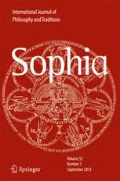Notes
The Jain and Buddhist traditions are both part of the śramaṇa movement which opposed Vedic sacrificial ritual and Brahmin privilege during the first millennium before the Common Era. Richard Gombrich has speculated that the Jain tradition played a significant role in the formation of Buddhism as a source of concepts and practices which the Buddha to some extent critiqued and to some extent retained in his own teachings. See Richard Gombrich, What the Buddha Thought (Oxford: Oxford University Press, 2009), pp. 45–59.
David Ray Griffin, Reenchantment without Supernaturalism: A Process Philosophy of Religion (Ithaca: Cornell University Press, 2001), p. 22.
Umāsvāti, Tattvārtha Sūtra (2007) 1:9–12.
Such as the ‘neoclassical’ theism proposed by thinkers in the process tradition, such as Alfred North Whitehead, Charles Hartshorne, John Cobb, David Ray Griffin, and others. See Hartshorne, The Logic of Perfection and Other Essays in Neoclassical Metaphysics (Whitefish, Montana: Literary Licensing, 2011).
John E. Cort, Jains in the World: Religious Values and Ideology in India (Oxford: Oxford University Press, 2001), pp. 91–93.
Padmanabh S. Jaini, The Jaina Path of Purification (Berkeley: University of California Press, 1979), pp. 81–82.
Christopher Key Chapple, personal communication. A similar moral or spiritual shading given to ostensibly physical concepts of dynamism and inertia can be found in the Sāṃkhya tradition—which seems to be a close cousin of Jainism in many respects—in the form of its teaching of the three guṇas, or qualities which make up phenomenal existence. In Sāṃkhya thought, rajas and tamas, respectively, are principles of activity and inertia; but these qualities also possess moral connotations, with rajas being superior to tamas, and the sattva guṇa being superior to both.
Ṛg Veda 10.90.
Jaini, pp. 127–130.
Vincent Sekhar, Dharma in Early Brahmanic, Buddhist, and Jain Traditions (Delhi: Sri Satguru Publications, 2003), p. 12.
Umāsvāti, Tattvārtha Sūtra (2007) 5:9. Translation mine.
Umāsvāti, Tattvārtha Sūtra (2007) 1:4.
Cort, p. 123.
Sam Harris, Letter to a Christian Nation (New York: Random House, 2006), pp. 22–23.
Jaini, p. 89.
Piotr Balcerowicz, Early Asceticism in Jainism: Ājivikism and Jainism (London: Routledge, 2016), p. 326.
Ibid, pp. 174–185; 220–226.
Bhagavatī Sūtra 9:386. Translation by Matilal. Cited in Bimal Krishna Matilal, Anekāntavāda: The Central Philosophy of Jainism (Allahabad, L.D. Institute of Indology, 1981), p. 19.
The approach attributed to Mahāvīra in the Jain Āgamas to the ‘unanswerable’ questions can be profitably compared to that attributed to the Buddha, particularly as understood in the Madhyamaka system, developed by Nāgārjuna (c. second–third century CE). Matilal describes the Buddhist approach as ‘exclusive’ middle path, in that the Buddha rejects all pairs of alternatives as finally inadequate to the description of truth, whereas the Jain approach is an ‘inclusive’ middle path, showing that each perspective has some validity, even if none can serve as a comprehensive picture of reality. See Matilal, p. 18.
References
Balcerowicz, P. (2016). Early asceticism in Jainism: Ājivikism and Jainism. Routledge.
Cort, J. E. (2001). Jains in the world: Religious values and ideology in India. Oxford University Press.
Gombrich, R. (2009). What the Buddha thought. Oxford University Press.
Griffin, D. R. (2001). Reenchantment without supernaturalism: A process philosophy of religion. Cornell University Press.
Harris, S. (2006). Letter to a Christian nation. Random House.
Hartshorne, C. (2011). The logic of perfection and other essays in neoclassical metaphysics. Literary Licensing.
Jaini, P. S. (1979). The Jaina path of purification. University of California Press.
Matilal, B. K. (1981). Anekāntavāda: The central philosophy of Jainism. Allahabad, L.D. Institute of Indology.
Sekhar, V. (2003). Dharma in early Brahmanic, Buddhist, and Jain traditions. Sri Satguru Publications.
Umāsvāti. (2007). Tattvārtha Sūtra. Manu Doshi, trans. JAINA–Federation of Jain Associations in North America.
Author information
Authors and Affiliations
Corresponding author
Additional information
Publisher's Note
Springer Nature remains neutral with regard to jurisdictional claims in published maps and institutional affiliations.
Rights and permissions
About this article
Cite this article
Long, J.D. From a Certain Point of View… Jain Theism and Atheism. SOPHIA 60, 623–638 (2021). https://doi.org/10.1007/s11841-021-00857-1
Accepted:
Published:
Issue Date:
DOI: https://doi.org/10.1007/s11841-021-00857-1

